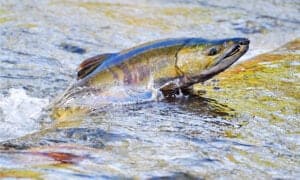One of the most popular fish in Alaska is salmon. There are many types of salmon in Alaska, each with unique characteristics and health advantages. While some salmon prefer to lounge on the river’s bottom, others enjoy swimming upwards and living a more active lifestyle.
In general, there are seven total species of salmon. These include pink, sockeye, chum, chinook, coho, Atlantic, and masu salmon. These fish are anadromous, migrating from saltwater to freshwater to spawn. However, there are only five types of salmon in Alaska: The pink salmon, the Chinook salmon, the Coho salmon, sockeye salmon, and chum salmon.
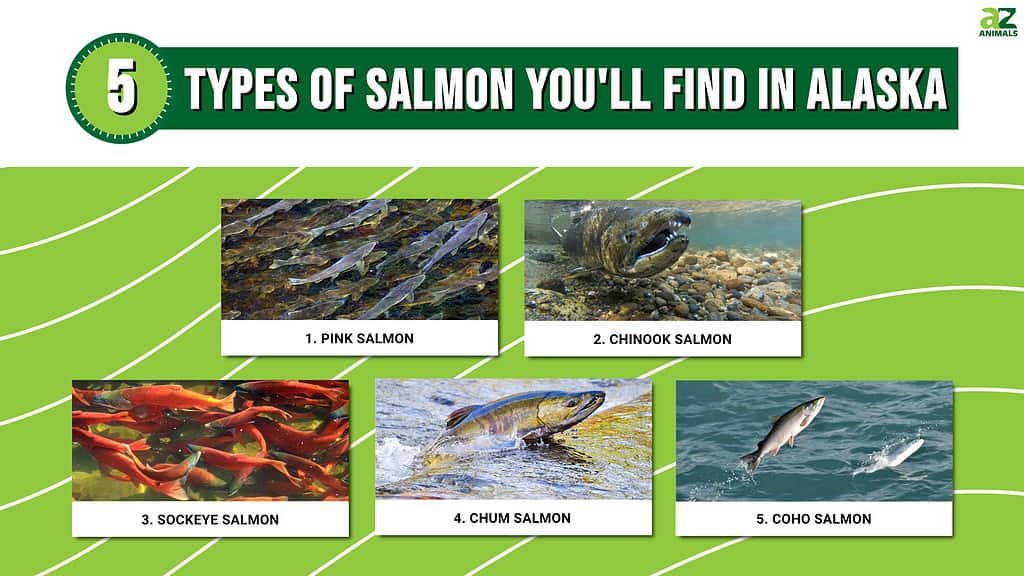
Salmon are a crucial source of nutrition for many creatures, including bears, eagles, and humans. They are keystone species in their ecosystems. Their presence or absence can have a significant influence on the condition of their environment. To put it simply, salmon are some seriously important fish.
Due to overfishing and habitat destruction, Alaskan salmon populations have decreased recently. However, initiatives are being taken to safeguard these species and increase their numbers.
In this in-depth guide, we’ll take a look at everything you need to know about the five main types of salmon in Alaska.
What Are Salmon?
Salmon are fish that belong to the Salmonidae family and are prized by humans for their tender, light pink flesh. They reproduce and hatch in freshwater but go into the sea as adults since they are anadromous fish. Salmon are reputed to return to the same spawning grounds year after year. These fish are frequently employed as an indicator species because, like their cousins the trout, they are extremely sensitive to environmental changes.
Salmon and farmers have frequently clashed over water rights in the west, where drought circumstances have caused a significant amount of water to be diverted to cultivation. Conservationists contend that fish require habitat just as much as people do food, and they have attempted to safeguard it to some extent by regulating water use, closely observing fisheries, and introducing salmon to new locations. They have been successfully farmed, and in some situations, farmed fish could be a better ecological choice than salmon that has been captured in the wild.
Salmon Description
These fish have dark-mottled upper bodies and creamy lower bodies, a tiny adipose fin between the tail and dorsal fins, and a prominent, protruding mouth, which gives them a trout-like appearance. In contrast to trout, salmon have 12 or more rays on their anal fins, and their lips are frequently dark or black. The meat is treasured by many customers who appreciate its mild flavor and rich pink flavor and is high in omega-3 fatty acids. As a result, despite good fisheries management, many are threatened with extinction as a result of overfishing.
Salmon Environments
Salmon may be found in the Atlantic and Pacific oceans, with one epic Atlantic fish reaching a record weight of 100 pounds. Although both kinds of fish will travel great distances to reach the sea, Pacific fish are typically smaller on average. Over their lives, salmon will make multiple trips up and down streams to spawn, return to the sea, and repeat the process. They have long been a staple of human diets and are important figures in the mythologies of many Western Native American tribes.
Salmon Types
Biologists commonly refer to groups of fish by the river they inhabit and the name of the species, as is the case, for example, with Sacramento River Chinook, because salmon prefer to run along the same river throughout their lifecycle. Five distinct species have been identified: chinook, coho, chum, sockeye, and pink. They are all commercially fished, and the majority are considered threatened species because of the decline in their habitats. Wild salmon once had a vast variety of genetic variants, coming from different rivers around the Pacific and Atlantic seas. Unfortunately, the genetic variety is decreasing because of the pressure from commercial fishing.
Interesting Facts About Salmon
The saber-tooth salmon is the first species of salmon that has been found in fossils dating as far back as 7 million years in North America. These fish were enormous; some of them may have reached a length of 10 feet.
Salmon species found in Alaska and North America, in general, include chinook, coho, chum, sockeye, and pink salmon. Masu salmon are found solely in Asia, while Atlantic salmon are found only in the Atlantic Ocean (obviously). While Pacific and Atlantic salmon are distantly related, they cannot interbreed because the two species have different numbers of chromosomes.
The smallest and most prevalent species of salmon are pink salmon. The biggest salmon are chinooks, which may weigh more than 100 pounds each. These are the least common species, however. It’s interesting to note that both species have the same number of scales.
Salmon Mating Practices
Pacific salmon are semelparous, which means that the majority of adults pass away after mating and end up as food and nutrients for the freshwater systems where they spawn. Although females are capable of producing up to 10,000 eggs, fewer than 1% of these eggs will develop into adults.
Adult salmon stop eating when they return to freshwater. Adults may therefore live without eating for six months while still transferring body fat to their gametes for reproduction. Salmon can also hear by vibrating a series of sensory pores on their flanks known as lateral lines in response to low-frequency sound waves that travel through the water.
Individuals that are in the saltwater phase of their life cycle move around 18 miles per day on average, and they can sustain this rate over long distances. These fish can travel 1,864 miles or more through freshwater upstream to spawn. Salmon have been known to jump up to six feet in the air to navigate obstructions in rivers, which is the same height that some Olympic competitors can clear!
5 Types Of Salmon Found In Alaska
The five main types of salmon in Alaska are each unique, with unique abilities, appearances, and benefits to the human diet.
1. Pink Salmon
Species Name: Oncorhynchus gorbuscha
The pink salmon is often referred to as humpies or humpy salmon. At an average weight of three to five pounds, pink salmon are the smallest of the five types of salmon in Alaska. They can be found, though, up to roughly 14 pounds. Despite their small size, they are tough fighting fish, so don’t underestimate them when trying to fish for them.
With yearly commercial captures reaching 140 million fish, pink salmon are by far the most prevalent salmon species in Alaska. Pink salmon captured for use in commerce is almost exclusively canned. From late June and mid-October, Ketchikan streams host a large number of pink salmon spawning events.
Pink salmon are known as humpies because adult males have a sizable hump behind the head, a powerfully hooked snout, and keen teeth. The females develop an underbelly that is lighter in hue and has an olive-green tint. Adults that live in saltwater lack the hump characteristic and have backs that range in color from steel blue to blue-green, silver sides, and a white belly. Moreover, they have very distinct oval markings on their back, adipose fins, and both tail lobes.
Contrary to popular belief, pink salmon from the ocean are delicious whether consumed shortly after being caught or, more frequently, smoked. In particular, the flesh is tender after freezing. Pink salmon is a popular choice for commercial and recreational anglers due to their wonderful flavor and high concentrations of omega-3 fatty acids.

Pink salmon (pictured) are the most prevalent salmon species in Alaska.
©COULANGES/Shutterstock.com
2. Chinook Salmon
Species Name: Oncorhynchus tshawytscha
The Chinook salmon, sometimes referred to as the king salmon, is the biggest and least common species of salmon. It has a superb flavor and can reach hefty weights of more than 40 pounds.
Although white Chinook salmon can sometimes be found, red Chinook salmon is the most prevalent flesh color. An adult Chinook salmon can be identified by its tail, which has dots that run up and down the length of the fin, and its black mouth lining.
Countries like Japan, China, and Russia gather salmon eggs from the Chinook salmon to make caviar. One of Alaska’s most lucrative commercial fisheries farm the Chinook salmon, whose great size and premium meat make it a delicacy around the world. One of the most sought sport fish in Alaska is the chinook salmon.
The Chinook salmon is the state fish of Alaska. A 126-pound Alaskan Chinook salmon was the biggest ever caught in history, and it was caught in a fish trap in 1949. While they can be caught year-round, the ideal times to fish for Chinook salmon in Alaskan streams are May, June, and July.
Chinook salmon are very oily fish. As such, they have a buttery taste. It is delicious served as steaks and can also be served fresh or frozen. The meat of this fish has a very low salt content and is a good source of protein, niacin, vitamin B12, selenium, and omega-3 fatty acids. The Chinook salmon, like many other species of salmon, is at risk of becoming endangered in a number of coastal regions of the United States.
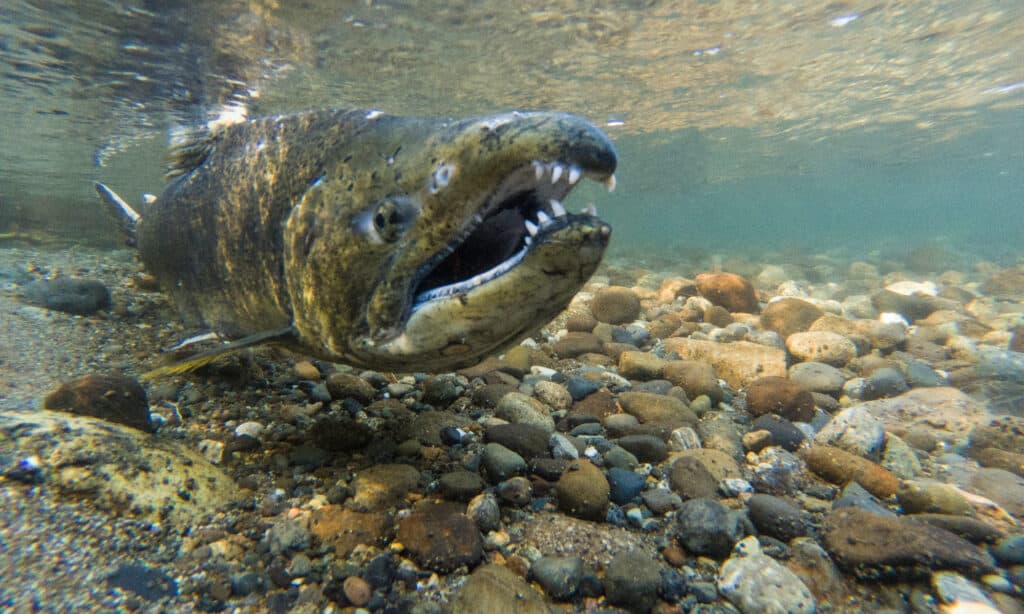
Chinook salmon (pictured) are considered delicacies outside of North America.
©Kevin Cass/Shutterstock.com
3. Sockeye Salmon
Species Name: Oncorhynchus nerka
In Alaska, sockeye salmon are the most significant salmon species commercially. Pink and chum salmon are harvested in greater quantities, while sockeye salmon are of superior quality and fetch considerably higher prices. More than 50% of the sockeye salmon that is captured is exported to markets in the United States and Japan frozen. Sockeye roe, which are the eggs of the fish, is extremely expensive in Japan. The world’s sockeye salmon capital is Bristol Bay, Alaska.
A typical sockeye salmon weighs around six pounds and may reach lengths of three feet. Nonetheless, a fish between 20 and 24 inches is more common. Sockeye salmon that are spawning, including males and females, have a rich red coloring. When their tail loses most of its pigment, its head changes to a greenish hue. A big kype and prominent shoulders appear on the male during the spawning season. Between July and October is the traditional time that adult sockeyes return to spawn. The amount of time that each species of salmon fry spends in freshwater is predetermined. Sockeye salmon specifically will remain in freshwater for a year or two.
If you plan to catch one of these beauties, be prepared for a fight! They are very strong fish that will leap and jump to escape. They’re a fan favorite of fly fishers for this reason.
Fresh and smoked sockeye salmon are both delicious. The best fish for lox, a velvety, gently smoked salmon dish sometimes served on bagels, is sockeye salmon.
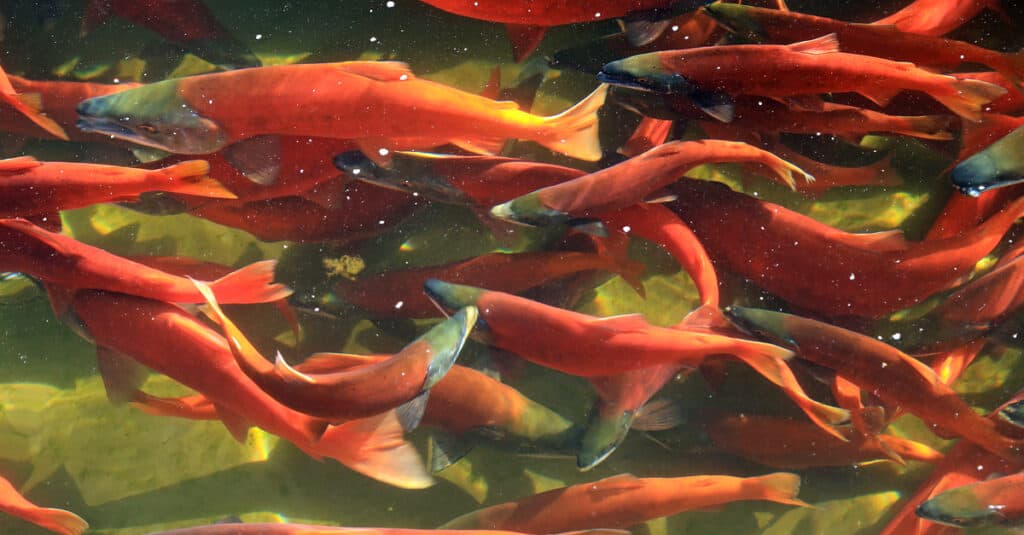
Sockeye salmon (pictured) are known for their bright red bodies.
©JCA Images/Shutterstock.com
4. Chum Salmon
Species Name: Oncorhynchus keta
Chum salmon are also known as dog salmon. Since chum salmon are fierce fighters with a lot of endurance, sport fishermen enjoy catching them. Fresh and frozen fish have seen a rise in popularity in Europe and Japan, where large-scale commercial chum salmon harvesting is now taking place. In nearly 200 small towns in interior Alaska, chum salmon have historically been a significant source of food for native people and their pet dogs.
If you catch a chum salmon in saltwater, its back will likely be shiny greenish-blue with black speckles. In fact, while swimming in the ocean, they resemble the sockeye salmon. The best ways to prepare chum salmon are to smoke or dry them.
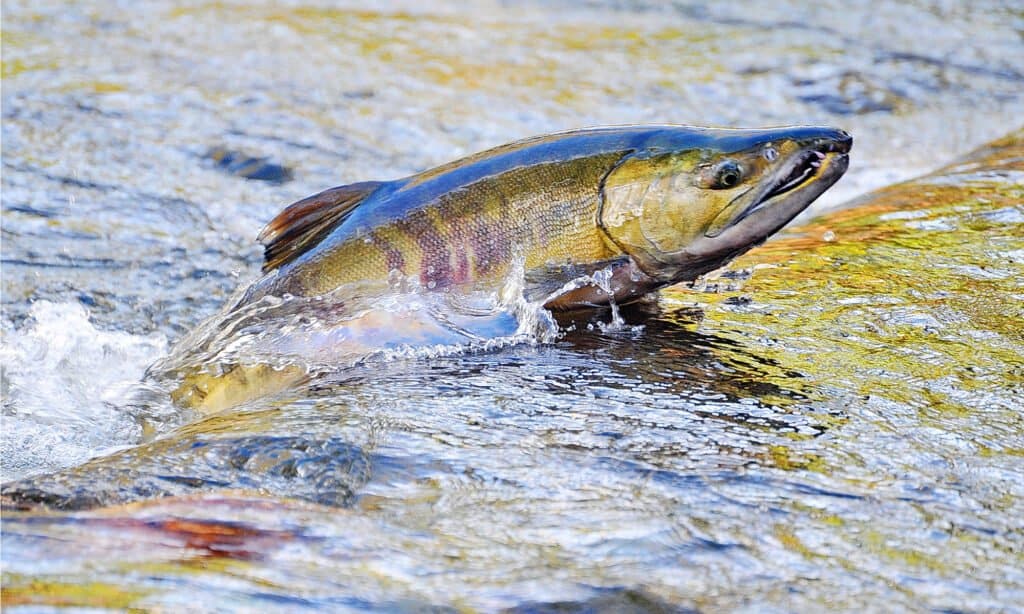
Chum salmon (pictured) are one of the fiercest of Alaska’s salmon species.
©The Old Major/Shutterstock.com
5. Coho Salmon
Species Name: Oncorhynchus kisutch
The silver salmon is another name for the Coho salmon. It is the second-largest species of salmon to be found off the coast of Alaska. In Europe, premium Coho salmon is frequently marketed whole and frozen. Coho salmon is popular among restaurant owners because the fillets are the ideal size and they maintain their orange-red hue. Coho salmon typically measure between 24 and 30 inches in length and weigh between 8 and 12 pounds on average.
Because they are fished by fishermen in both freshwater and marine environments, Coho salmon are also a very significant recreational fish in Alaska, contributing millions of dollars yearly to the state’s economy. Not surprisingly, Alaska provides 75% of the Coho caught in the United States.
Coho salmon have silvery flanks and a shiny blue back with sporadic black markings while swimming in open water. Males that are ready to spawn in freshwater have brilliant red on their flanks, along with maybe bright green on their back and heads and darker coloring on their bellies. To differentiate a Coho salmon from the other types of salmon in Alaska, look for its black mouth inside, which is otherwise white save for the gum line.
Coho salmon are tough competitors, have a soft mouth, and frequently make lengthy runs that threaten to spool reels. Sometimes, they may even run directly at you, giving you the impression that all hope is gone. The best periods to catch Coho are from July through November.
This type of salmon tastes fantastic straight off the grill and also smokes well. Fresh and frozen Coho salmon are both excellent choices for at-home cooks who are just trying out this species.

Coho salmon (pictured) are excellent jumpers.
©iStock.com/John Pennell
Are Salmon Numbers Going Down?
Salmon really are fascinating fish. They can be found around the coasts of the Atlantic and Pacific oceans, and they are abundant around Alaska. Despite dwindling populations, efforts have been made to help these five species boost their numbers. Salmon stocks are predicted to rebound thanks to tighter regulation and supervision, and several states in the U.S. have begun active public awareness programs to inform customers about the fish and the legal penalties of overfishing.
Fortunately, it looks like we’ll be able to enjoy salmon as part of our diet for years to come!
Summary Of The 5 Types Of Salmon You’ll Find In Alaska
| Number | Salmon |
|---|---|
| 1 | Pink Salmon |
| 2 | Chinook Salmon |
| 3 | Sockeye Salmon |
| 4 | Chum Salmon |
| 5 | Coho Salmon |
The photo featured at the top of this post is © Martin Rudlof Photography/Shutterstock.com
Thank you for reading! Have some feedback for us? Contact the AZ Animals editorial team.




